Chera dynasty
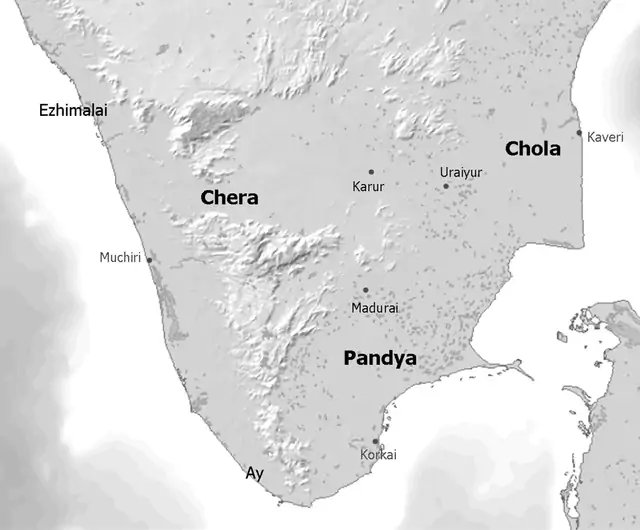
Chera dynasty

| Capital | Early CherasKodungallur Cheras (Kulasekharas)Venadu Cheras |
|---|---|
| Common languages | |
| Religion | Hinduism |
| Today part of | India |
The Chera dynasty (Cēra) was one of the principal lineages in the early history of the present day states of Kerala and Tamil Nadu in southern India.[6] Together with the Cholas of Uraiyur and the Pandyas of Madurai, the early Cheras were known as one of the three major powers (muventar) of ancient Tamilakam (a macro region[6] in south India) in the early centuries of the Common Era.[8][9]
The people of the Chera country owed their importance to exchange of spices, especially black pepper, with Middle Eastern and Graeco-Roman merchants.[10][11][6] The age and antiquity of the dynasty is difficult to establish.[12][13][14] The Cheras of the early historical period (c. second century BCE - c. third century CE[6]) are known to have had their original centre at Karur/Karuvur-Vanchi in interior Tamil Nadu and strategic outlets to their harbours at Muchiri (Muziris) and Thondi (Tyndis) on the Indian Ocean coast (Kerala).[14][15] The early historic Chera chiefdom is often described as a "redistributive economy based on kinship". It was largely shaped by agriculture, of both crops and livestock, and "predatory politics".[6] Inscriptions discovered from Karur dated to c. 1st - 2nd century CE, describe Ilam Kadungo, son of Perum Kadungo, and the grandson of Ko Athan Cheral of the Irumporai clan.[16] Inscribed portrait coins with Brahmi legends give a number of names, such as Mak-kotai, Kuttuvan Kotai, Kollippurai, and Kolli Irumporai.[17] Reverse of these coins often contained the Chera bow and arrow symbol.[17]
The anthologies of early Tamil poems are a major source of information about the early Cheras. The poems mention the names of a number of Chera chiefs, and the "court poets" who extolled them. The internal chronology of this collection is still far from completely settled and a connected account of the history of the period is an area of active research.[9] Chenguttuvan Chera, the most renowned of the early Cheras, is also famous for the traditions surrounding Kannaki, the principal female character of the Tamil epic poem Chilapathikaram.[18][14] Other sources for the early Cheras include Tamil Brahmi cave label inscriptions[19] and inscribed coins, classical Sanskrit works and accounts by Graeco-Roman writers.[14] After the end of the early historical period, around the 3rd-5th century CE, there seems to be a period where the Cheras' power declined considerably.[20]
The "Kongu Cheras'" are known to have controlled Karur-Vanchi in central Tamil Nadu in the medieval period.[14] The (Western) Cheras of Makotai/Vanchi (former Muchiri, modern Kodungallur), previously known as Kulashekharas, were in power between c. 9th and 12th century in Kerala.[8][22] The exact nature of the relationships between the various branches of Chera rulers is somewhat unclear.[14] It is known that the Cheras, of both Makotai and Karur, were intermittently subject to the Pandya Kingdom and the Chola Empire among others.[20] Even after the dissolution of the Kodungallur Chera kingdom, royal inscriptions and temple grants, especially from outside Kerala proper, continued to refer the country and the people as the "Cheras/Keralas". The rulers of Venadu ("the Venadu Cheras"), based out of the port of Kollam in south Kerala, claimed their ancestry from the Kodungallur Cheras.[20] Ravi Varma Kulasekhara, their most ambitious ruler, set out to expand his kingdom by annexing the ruins of the other southern kingdoms.[23] In the modern period the rulers of Cochin and Travancore (in Kerala) also claimed the title "Chera".[22]
| Capital | Early CherasKodungallur Cheras (Kulasekharas)Venadu Cheras |
|---|---|
| Common languages | |
| Religion | Hinduism |
| Today part of | India |
Etymology
The term Chera - and its variant form "Keralaputas" - stands for the ruling lineage and the country associated with them.[19]
The etymology of "Chera" is still a matter of considerable speculation among historians.
One approach proposes that the word is derived from Cheral, a corruption of Charal meaning "declivity of a mountain" in Tamil, suggesting a connection with the mountainous geography of Kerala.[2] Another theory argues that the "Cheralam'' is derived from "cher" (sand) and "alam" (region), literally meaning, "the slushy land".[2] Apart from the speculations mentioned, a number of other theories do appear in historical studies.[4][2]
In ancient non-Tamil sources, the Cheras are referred to by various names.
The Cheras are referred as Kedalaputo (Sanskrit: "Kerala Putra") in the Emperor Ashoka's Pali edicts (3rd century BCE).[26] While Pliny the Elder and Claudius Ptolemy refer to the Cheras as Kaelobotros and Kerobottros respectively, the Graeco-Roman trade map Periplus Maris Erythraei refers to the Cheras as Keprobotras. All these Graeco-Roman names are evidently corruptions of "Kedala Puto/Kerala Putra" probably received through relations with northern India.[14] [27]
The term Cheralamdivu or Cheran Tivu and its cognates, meaning the "island of the Chera kings", is a Classical Tamil name of Sri Lanka that takes root from the term "Chera".[28]
History
Cheras of ancient south India

An approximate representation of the Chera territory in the early historical period (c. second century BCE-c.
Recent theories on ancient south Indian history suggest that the three major rulers – the Pandya, the Chera and the Chola – based originally in the interior Tamil Nadu, at Madurai,VanchiKodungallur in Kerala, and Uraiyur respectively, had established "strategic outlets" to the Indian Ocean namely Korkai, Muchiri (Muziris), and Kaveri Poompattinam respectively.[15] Territory of the Chera polity of the early historical period consisted of the present day central Kerala and western Tamil Nadu.[19] The political structure of the Chera chiefdom was based on communal holding of resources and kinship-based production. The authority was determined by" the range of redistributive social relationships sustained through predatory accumulation of resources".[6]
The Cheras are referred to as Kedalaputo (Sanskrit: "Kerala Putra") in the Emperor Ashoka's Pali edicts (3rd century BCE, Rock Edicts II and XII).[26] The earliest Graeco-Roman accounts referring to the Cheras are by Pliny the Elder in the 1st century CE, in the Periplus of the 1st century CE, and by Claudius Ptolemy in the 2nd century CE. [29][16]
A number of Sanskrit works do mention the family and land of the Cheras/Keralas.
Whether the particular references were present in the earliest oral forms or were added subsequently is a matter of considerable discourse.
The Aranyakas are a later development of the Brahmanas (explanations of the Vedas), which were originally composed c. 7th-8th century BCE. There are also brief references in the present forms of the works by author and commentator Katyayana (c. 3rd - 4th century BCE), author and philosopher Patanjali (c. 2nd century BCE) and Maurya statesman and philosopher Kautilya (Chanakya) (c. 3rd - 4th century BCE) though Sanskrit grammarian Panini (c. 6th - 5th century BCE) does not mention either the people or the land.[30]
Archaeological discoveries
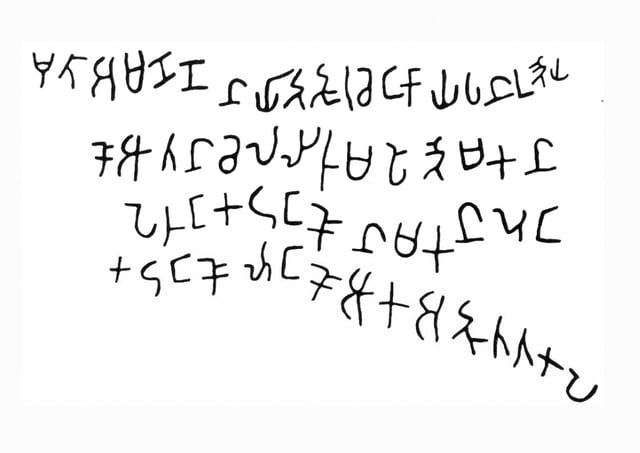
Tamil Brahmi inscription from Pugalur, near Karur
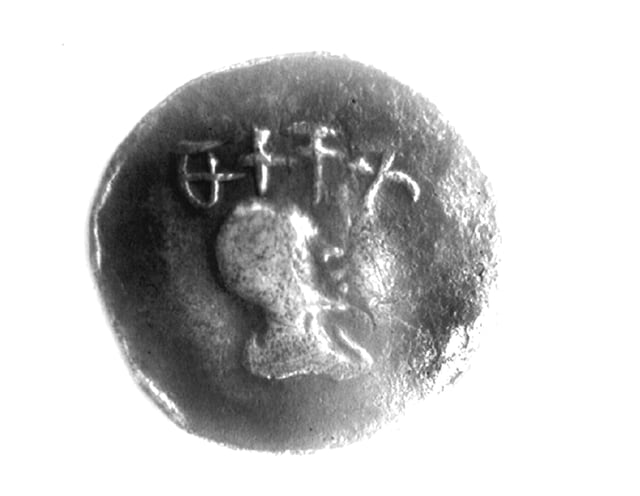
A Chera coin with Brahmi legend "Makkotai"
Archaeology has found epigraphic and numismatic evidence of the Early Cheras.[31][16] Two almost identical inscriptions discovered from Pugalur (near Karur) dated to c. 1st - 2nd century CE, describe three generations of Chera rulers of the Irumporai clan. They record the construction of a rock shelter for Jains on the occasion of the investiture of Ilam Kadungo, son of Perum Kadungo, and the grandson of Ko Athan Cheral Irumporai.[16] A short Tamil-Brahmi inscription, containing the word Chera ("Kadummi Pudha Chera") was found at Edakkal in the Western Ghats.[32]
Chera coinage
A number of coins, assumed to be of the Cheras, mostly found in the Amaravati riverbed, are a major source of early Chera historiography.[33] This includes a number of punch marked coins discovered from Amaravati riverbed. The square coins of copper and its alloys or silver have also been discovered. Most of these early square coins show a bow and arrow, the traditional emblem of the Cheras on the obverse, with or without any legend.[35] Silver-punch marked coins, an imitation of the Maurya coins, and with a Chera bow on the reverse, have been reported. Hundreds of copper coins, attributed to the Cheras, have been discovered from Pattanam in central Kerala.[17][36] Bronze dies for minting punch marked coins were discovered from a riverbed in Karur.[17]
Other discoveries include a coin with a portrait and the Brahmi legend "Mak-kotai" above it and another one with a portrait and the legend "Kuttuvan Kotai" above it.
Both impure silver coins are tentatively dated to c. 1st century CE or a little later.
The reverse side of both coins are blank.[33] The impure silver coins bearing Brahmi legends "Kollippurai", "Kollipporai"[17], "Kol-Irumporai" and "Sa Irumporai"[17] were also discovered from Karur. The portrait coins are generally considered as imitation of Roman coins.[17] All legends, assumed to be the names of the Chera rulers, were in Tamil-Brahmi characters on the obverse. Reverse often contained the bow and arrow symbol. [17] An alliance between the Cholas is evident from a joint coin bearing the Chola tiger on the obverse and the Chera bow and arrow on the reverse. Lakshmi-type coins of possible Sri Lankan origin have also been discovered from Karur.[17]
The macro analysis of the Mak-kotai coin shows close similarities with the contemporary Roman silver coin.[35] A silver coin with the portrait of a person wearing a Roman-type bristled-crown helmet was also discovered from Amaravati riverbed in Karur.
Reverse side of the coin depicts a bow and arrow, the traditional symbol of the Chera family.[33]
Cheras from early Tamil literature
A large body of Tamil works collectively known as the Sangam (Academy) literature (c. 2nd century BCE- 3rd century CE) describes a number of Chera, Pandya and Chola rulers.[37]Companion%20Studies%20to%20the%20Hi]][38]]]Among them, the most important sources for the Cheras are the* Pathitrupattu Purananuru[30]Pathitrupattu Ettuthokai era family.[9] Each ruler is praised in ten songs sung by a court poet.[39][37] However, the book is not worked into connected history and settled chronology so far.[40] Uthiyan Cheral, Nedum Cheral Athan and Chenguttuvan are some of the rulers referred to in the Tamil literature.[41]
A method known as Gajabahu-Chenguttuvan synchronism, is used by some historians to date the events described in the early Tamil literature to c. 1st - 2nd century CE.[41] Despite its dependency on numerous conjectures, the method is considered as the sheet anchor for the purpose of dating the events in the early Tamil literature.[42][43] elder brother. He also mentions Chenguttuvan's decision to propitiate a temple (virakkallu) for the goddess Pattini (Kannaki) at Vanchi.[45] A certain king called Gajabahu, often identified with Gajabahu, king of Sri Lanka (2nd century CE), was present at the Pattini festival at Vanchi.[46][47] In this context, Chenguttuvan can be dated to either the first or last quarter of the 2nd century CE.[18]
| Chera | Relation | Bard | Decade ofPathitrupattu | Notes | ||
|---|---|---|---|---|---|---|
| Uthiyan Cheral Athan | Earliest known ruler of the Chera family | Uthiyan Cheral was also known as "Vanavaramban" Cheral Athan.His headquarters were at Kuzhumur in Kuttanad.He is sometimes identified with the legendary Chera ruler who prepared food for the warring cousins at the Kurukshetra War in the epicMahabharata(Akananuru).[48]In the battle of Venni, Uthiyan Cheral was wounded on the back by the Chola rulerKarikala.Unable to bear the disgrace, the Chera committed suicide by slow starvation.[48] | ||||
| "Imayavaramban"Nedum Cheral Athan | Son of Uthiyan Cheral Athan | Kannanar[9] | II | Nedum Cheral Athan was also known as "Imayavaramban".He is praised for having subdued "seven crowned kings" to achieve the title ofadhiraja.With characteristic exaggeration, Kannanar also lauds the Chera for conquering foes fromKumarito the Himalayas.Nedum Cheral Athan, famous for his hospitality, gifted Kannanar with a part of Umbarkkattu.[48]The greatest of his enemies were theKadambaswhom he defeated in battles.He also attacked Yavana ships and held Yavana traders ransom.Nedum Cheral Athan was killed in a battle with a Chola ruler.The Chola is also said to have been killed by a spear thrown at him by Nedum Cheral Athan.Subsequently both queens performed sati in respect of their husbands.[48] | ||
| Palyani Sel Kelu Kuttuvan | Son of Uthiyan Cheral Athan | Palaik Kauthamanar[9] | III | Credited as the conqueror of Kongu[48] | ||
| Kalankakkanni Narmudi Cheral | Kappiyattukku Kappiyanar[9] | IV | Narmudi Cheral led an expedition against the Adigaiman Anji of Tagadur.Initially defeated by Nannan of Ezhimala in the battle of Pazhi, later defeated and killed Nannan in the battle of Vakai Perum Turai.[48][47] | |||
| Chenguttuvan Chera("Kadal Pirakottiya" Vel Kezhu Kuttuvan?) | Son of Nedum Cheral Athan | Paranar[9] | V | Chenguttuvan is identified with "Kadal Pirakottiya" Vel Kezhu Kuttuvan, son of Nedum Cheral Athan.He succeeded his father Nedum Cheral Athan.Vel Kezhu Kuttuvan is often identified with the legendary "Chenguttuvan Chera", the most illustrious ruler of the Early Cheras.Under his reign, the Chera territory extended from Kollimalai (near Karur Vanchi) in the east to Thondi and Mantai (Kerala) on the western coast.The wife of Chenguttuvan was Illango Venmal (the daughter of a Velir chief).[47][48]In the early years of his rule, the Kuttuvan successfully intervened in a succession dispute in the Chola territory and established his relativeKillion the Chola throne.The rivals of Killi were defeated in the battle of Nerivayil, Uraiyur.TheKadambasare described as the arch enemies of the Chera ruler.Kuttuvan was able to defeat them in the battle of Idumbil, Valayur.The "fort" of Kodukur in which the Kadamba warriors took shelter was stormed.Later the Kadambas (helped by the Yavanas) attacked Kuttuvan by sea, but the Chera ruler destroyed their fleet.Kuttuvan is said to have defeated the Kongu people and a warrior called Mogur Mannan.[18] | ||
| Adu Kottu Cheral Athan | Successor of Vel Kezhu Kuttuvan[46] | Kakkaipadiniyar Nachellaiyar (poetess)[9] | VI | |||
| Selva Kadumko Valia Athan | Son of Anthuvan Cheral | Kapilar[9] | VII | Selvakadumko Valia Athan's residence was at the city of Thondi.He married the sister of the wife of Nedum Cheral Athan.Selva Kadumko defeated the combined armies of thePandyasand theCholas.[9][46]He is sometimes identified as the Ko Athan Cheral Irumporai mentioned in the Aranattar-malai inscription of Pugalur (c. 2nd century CE).[46][9] | ||
| Perum Cheral Irumporai | Arichil Kizhar[9] | VIII | "Tagadur Erinta" Perum Cheral Irumporai defeated the combined armies of the Pandyas, Cholas and that of the chief of Tagadur.He capturedTagadurwhich was ruled by the powerful ruler Adigaman Ezhni.He is also called "the lord of Puzhinadu and "the lord of Kollimalai" and "the lord of [Poom]Puhar".Puhar was the Chola headquarters.Perum Cheral Irumporai also annexed the territories of a minor chief called Kaluval.[51] | |||
| Illam Cheral Irumporai | Perunkundur Kizhar[9] | IX | Illam Cheral Irumporai defeated the Pandyas and the Cholas and brought immense wealth to his base Vanchi.[51] | |||
| "Yanaikatchai" Mantaran Cheral Irumporai | Mantaran Cheral Irumporai ruled from Kollimalai (near Karur Vanchi) in the east to Thondi and Mantai on the western coast.He defeated his enemies in a battle at Vilamkil.The famous Pandya ruler Nedum Chezhian (early 3rd century CE[53]) captured Mantaran Cheral as a prisoner.However, he managed to escape and regain the lost territories.[54] | |||||
| Kanaikkal Irumporai | Kanaikkal Irumporai is said to have defeated a chief called Muvan and imprisoned him.The Chera then brutally pulled out the teeth of the prisoner and planted them on the gates of the city of Thondi.Upon capture by the Chola rulerSengannan, Kanaikkal committed suicide by starvation.[54] | |||||
Cheras in the medieval period
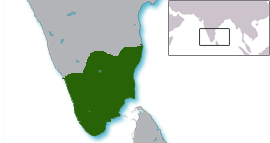
An approximate extent of Kalabhra supremacy in southern India.
After the end of the early historical period in south India, c. 5th century CE, there seems to be a period where the Chera family's political prestige and influence declined considerably.[20] It is possible that with the decline of the Roman trade in the 5th century, there was a corresponding fall in the stature of the Cheras.[55] The Cheras of the early historical period had an important base at Karur - probably identical with the early historic Vanchi - in central Tamil Nadu and strategic outlets to their harbours at Muchiri (Muziris) and Thondi (Tyndis) on the Indian Ocean coast (Kerala). Gradually towards the end of the early historical period, Karur seems to have acquired much prominence. By the 8th - 9th centuries it came to be known as "Vanchi Karur".[55]
Little is known for certain about the Chera family during this period.
Tradition tells that the Kalabhra (Kalvar[53]) rulers kept the Chera, Chola and Pandya rulers in their confinement.[22] The Kalabhras were marginalised around the 5th century by the rise of the Chalukyas and the Pallavas.[22] The Rashtrakutas were the other major power in southern India. They all claim to have overrun the Cheras/Keralas. A number of inscriptions mention their victories over the kings of the Chera country.[56][57] [58] Small buffer polities, such as that of the Ay-Vels, oscillated their allegiance in this period between major rulers.[59][60][61]
By the 7th and the 8th centuries, large portions of southern India was under the control of the Pallava and Pandya rulers. It is likely that the surviving Chera/Kerala royals were the vassals of the Pallavas and the Pandyas. Several inscriptions of the Kongu Cheras - the Cheras ruling from Karur - in copper and stone, mostly placed between 9th and 10th centuries, are found in central Tamil Nadu. This line of kings was increasingly coming under Pandya influence and a new Chera kingdom was taking shape in modern Kerala. Cheras of Karur are described as members of the "Chandraditya Kula" (the Kodungallur Cheras generally describe themselves as members of "Surya Vamsha").[55]
It seems that by the 8th century CE, the old Chera territory was split into two separate kingdoms, one based at Karur in central Tamil Nadu and the other based at Kodungallur in Kerala. Royal inscriptions and temple grants, the major source of information about the rulers of this period, refer to both clans as the Cheras/Keralas. Identification of the Cheras in each record is a matter of major scholarly discourse.[14][20] The exact nature of the relation between the Cheras of Kongu and the Cheras of Kodungallur remains obscure.[55]
Kodungallur Cheras

Depiction of "Cherman Perumal" Nayanar (Brihadisvara Temple, Thanjavur)
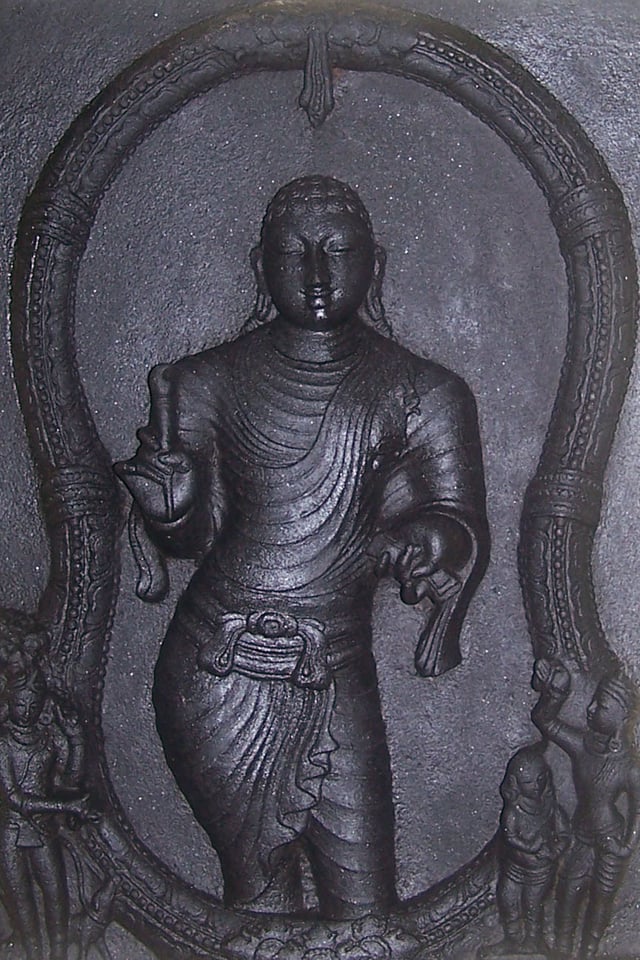
Ilango Adigal, author of the epic Chilapathikaram.
A line of rulers, described in royal charters and temple inscriptions as the Chera kings, are known to have ruled what is now Kerala between the 9th and 12th century CE.[8] Their ruling base was the city of Makotai/Vanchi (Sanskrit: Mahodayapura), modern Kodungallur. The history of Kerala during this period is an active area of scholarly research and debate. Historians tend to identify Nayanar saint Cherman Perumal and Alvar saint Kulasekhara with some of the earliest rulers of this kingdom.[62][63]
The nature of the Chera state of Kodungallur is an ongoing academic debate.
An earlier version of historiography had believed that this "Second Chera Empire", or "Kulasekhara Empire" was a highly centralized kingdom.
However, critical research in the late 1960s and early 1970s offered a major corrective to this.
Recently (2002), suggestions pointing to the other extreme, that the king at Kodungallur had only a "ritual sovereignty" and the actual political power rested with "a bold and visible Brahmin oligarchy" has emerged.
While the earlier model of a highly centralized "empire" is considered not acceptable by historians, the third model (2002) is yet to be endorsed by them.[19]
Political units known as "nadus", controlled by powerful hereditary chiefs or by households, occupied central importance in the structuring of the Kodungallur Chera state.
The rulers of the nadus usually acted with the help of a military retinue.
Nadu in medieval Kerala is often compared with the rashtra under the Rashtrakutas and padi under the Cholas. The prominent nadus continued to exist even after the end of the Chera rule during the beginning of the 12th century.[64]
The Cheras of Kodungallur were intermittently subject to the Chola Empire. They strategically fought battles and formed alliances with the Pandyas and the Cholas.[65][66] The Chera kingdom was eventually dissolved in 12th century, and most of its autonomous chiefdoms ("the nadus"[64]) became independent. Venadu in southern Kerala was one of these daughter states. [67][68][69][8] In the modern period, the rulers of Cochin and Travancore (in Kerala) also claimed the title "Chera".[22]
| Elamkulam P. N. Kunjan Pillai(1955 and 63)[70] | M. G. S. Narayanan(1972)[71] |
|---|---|
|
|
Venadu Cheras: late medieval to early modern
Even after the dissolution of the Kodungallur Chera kingdom, royal inscriptions and temple grants, especially from outside Kerala proper, continued to refer the country and the people as the "Cheras/Keralas".
When the Kodungallur Chera (reviously Kulasekhara) kingdom was eventually dissolved in 12th century, most of its autonomous chiefdoms ("the nadus") including Venad became independent.[67][68][69][8] The rulers of Venadu, based out of the port of Kollam in southern Kerala, claimed their ancestry from the Kodungallur Cheras.[20] The Venad rulers had an oscillating relationship with their powerful eastern neighbours, the Pandyas of Madurai. With Kolathunadu in northern Kerala, it remained the most significant kingdom in Kerala till the emergence of the Zamorins of Kozhikode.[72] Ravi Varma Kulasekhara, the most ambitious ruler of Kollam, carried out a successful military expedition to Pandya and Chola lands in the early 14th century CE.[23] [73]
The rulers of Venad owed their importance to exchange of spices and other products with the Middle Eastern and Chinese merchants.[6][75][76][77] Venetian adventurer Marco Polo claimed to have visited Venad capital Kollam, a major centre of commerce and trade with East and West Asia. European colonisers arrived at Kollam in the late fifteenth century, primarily in pursuit of the Indian spices and textiles.[77][78][79][47] In the Venad royal family, like in most other royal houses in Kerala, the law of succession followed was based on matrilineal inheritance. The eldest son of the sister of the ruling king, not his own son, had the legal right to ascend the throne after the death of the king.[80][81][8]
In the modern period, the rulers of Venad paid an annual tribute to the rulers of Madurai.[83][78] By this time, the old state of Venad was divided into several autonomous collateral branches such as Trippappoor (Travancore), Elayadathu, (Kottarakara), Desinganad (Kollam), and Peraka Thavazhi (Nedumangad).[85][86][87] In the 18th century, Marthanda Varma (1706–1758), of Trippappoor (Travancore), successfully developed the state of Travancore. Varma routed all the major Nair nobles in Travancore, organised a standing army, defeated most of the chiefdoms in central Kerala, entered into strategic alliances with Europeans, supported Kerala traders in the place of the Europeans, and eventually formed one of the first modern states of southern India.[83] In the modern period the rulers of Travacore also claimed the title "Chera".[22]
Government
The extent of political formation in early historic southern India (c. second century BCE-c.
third century CE[6]) was a matter of considerable debate among historians.[9] Although earlier historians visualised early historic polities as full-fledged kingdoms, some of the recent studies rule out the possibility of state formation.[8][6][90] According to historian Rajan Gurukkal, ancient south India was a combination of several "unevenly evolved and kinship based redistributive economies of chiefdoms". These polities were structured by the dominance of agro-pastoral means of subsistence and predatory politics.[15] Kesavan Veluthat, another prominent historian of south India, uses the term "chief" and "chiefdom" for the Chera ruler and Chera polity of early historic south India respectively.[19]
Economy
The early Chera economy can be described as a predominantly "pastoral-cum-agrarian" based system.
The emphasis on agriculture increased with time, and provided the base for larger economic change.[53] The early historic south India (c. second century BCE-c.
third century CE[6]) can be described as a "semi-tribal political economy".
In a 2013 paper, historian Rajan Gurukkal describes ancient south India as a collection of "unevenly evolved and kinship-based redistributive economies."
Spice trade
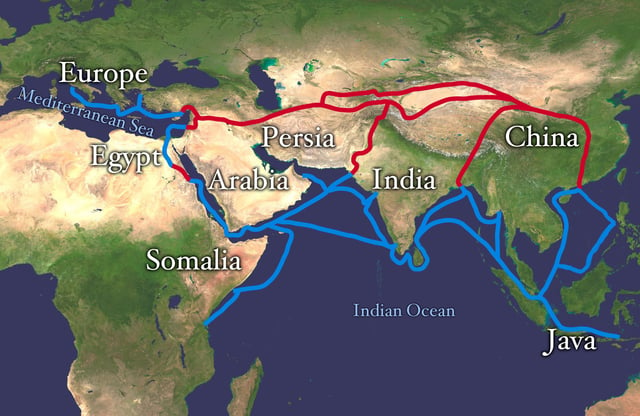
Silk Road (Red) and Spice Routes (Blues)
Exchange relations with the merchants from Graeco-Roman world, the "Yavanas", and with north India provided considerable economic momentum for the Chera chiefdom. Indian Ocean exchange was the major economic activity.[53] There is some difference of opinion with regard to the nature of the "spice trade" in ancient Chera country. It is disputed whether this "trade" with the Mediterranean world was managed on equal terms by the Tamil merchants, in view of the existence of apparently unequal political institutions in south India.[93] Some of the more recent studies point out that the "trade" was an exchange of "serious imbalance", because of its being between the Roman Empire and South India with uneven chiefdoms.[6]
The geographical advantages, like the favourable Monsoon winds which carried ships directly from the Arabia to south India as well as the abundance of exotic spices in the interior Ghat mountains (and the presence of a large number of rivers connecting the Ghats with the Arabian Sea) combined to make the Cheras a major power in ancient southern India.[11][6]
Spice exchange with Middle Eastern and Mediterranean (Graeco-Roman) navigators can be traced back to before the Common Era and was substantially consolidated in the early years of the Common Era.[6][94][95] In the first century CE, the Romans conquered Egypt, which probably helped them to establish dominance in the Indian Ocean spice trade. The earliest Graeco-Roman accounts referring to the Cheras are by Pliny the Elder in the 1st century CE, in Periplus Maris Erythraei of the 1st century CE, and by Claudius Ptolemy in the 2nd century CE.[27] The Periplus Maris Erythraei portrays the "trade" in the territory of Keprobotras in detail. Muziris was the most important centre in the Malabar Coast, which according to the Periplus, "abounded with large ships of Romans, Arabs and Greeks". Bulk spices, ivory, timber, pearls and gems were "exported" from the Chera country to the Middle East and Mediterranean kingdoms.[96]
It is known that the Romans brought vast amounts of gold in exchange for black pepper.[6][97][98][99] This is testified by the Roman coin hoards that have been found in various parts of Kerala and Tamil Nadu. Pliny the Elder, in the 1st century CE, laments the drain of Roman gold into India and China for luxuries such as spices, silk and muslin. The spice trade across the Indian Ocean dwindled with the decline of the Roman empire in the 3rd - 4th centuries CE.[6] With the exit of the Mediterraneans from the spice trade, their space was picked up by the Chinese and Arab navigators.[8]
Wootz steel
The famous damascus blades relied on the unique properties of the wootz crucible steel from medieval south India and Sri Lanka.[100] There are several ancient Tamil, Greek, Chinese and Roman literary references to high carbon Indian steel. The crucible steel production process started in the 6th century BC, at production sites of Kodumanal in Tamil Nadu, Golconda in Telangana, Karnataka and Sri Lanka and exported globally; the Chera Dynasty producing what was termed the finest steel in the world, i.e. Seric Iron to the Romans, Egyptians, Chinese and Arabs by 500 BC.[101][102][103] The steel was exported as cakes of steely iron that came to be known as "Wootz".[104] Wootz steel in India had high amount of carbon in it.
The method was to heat black magnetite ore in the presence of carbon in a sealed clay crucible inside a charcoal furnace to completely remove slag. An alternative was to smelt the ore first to give wrought iron, then heat and hammer it to remove slag. The carbon source was bamboo and leaves from plants such as Avārai.[104][105] The Chinese and locals in Sri Lanka adopted the production methods of creating wootz steel from the Cheras by the 5th century BC.[106][107] In Sri Lanka, this early steel-making method employed a unique wind furnace, driven by the monsoon winds. Production sites from antiquity have emerged, in places such as Anuradhapura, Tissamaharama and Samanalawewa, as well as imported artifacts of ancient iron and steel from Kodumanal. A 200 BC Tamil trade guild in Tissamaharama, in the South East of Sri Lanka, brought with them some of the oldest iron and steel artifacts and production processes to the island from the classical period.[108][109][110][111]
Society and culture
Early Cheras
In general, early Tamil literature reflects the Dravidian cultural tradition as well as elements of the northern Indian/Sanskritic cultural tradition, which by now was beginning to come into contact with southern India.[53] It is logical to conclude that most of the Chera population followed native Dravidian religions.[112] Religious practice might have consisted predominantly of conducting sacrifices to various gods, such as to the pre-eminent god Murugan.[53] The worship of departed heroes was a common practice in the Chera territory, along with tree worship and other kinds of ancestor worship. The war goddess Kottravai was propitiated with elaborate offerings of meat and toddy. It is theorised that Kottravai was assimilated into the present-day form of the goddess Durga.[112] It is thought that the first wave of Brahmin migration came to the Chera territory around the 3rd century BCE with or behind the Jain and Buddhist missionaries. It was only in the 8th century CE that the Aryanisation of the old Chera country reached its organised form[113]. Though the vast majority of the population followed native Dravidian practices, a small percentage of the population, mainly migrants, followed Jainism, Buddhism and Brahmanism.[112] Populations of Jews and Christians were also known to have lived in Kerala.[114][115][116]
Early Tamil literature does make a number of references to social stratification, as expressed by use of the word kudi (“group”) to denote "caste".[53] A striking feature of the social life of the early historic period (c. second century BCE-c. third century CE[6]) is the high status accorded to women.[117] [90]
Agriculture and pastoralism were the primary occupations of the people.
Various agricultural occupations such as harvesting, threshing and drying are described in the early Tamil literature.
Poets and musicians were held in high regard in society.
Early Tamil literature is full of references about the lavish patronage extended to court poets.
There were professional poets and poetesses who composed poems praising their patrons and were generously rewarded for this.[118]
Kodungallur Cheras/Kulasekharas
An identity different from the Tamil-speaking people to the east of the Western Ghats gradually emerged in Kerala in the medieval period. Oldest forms of Malayalam language and earliest signs of increased Namboothiri Brahmin influence are also attested in this period. A new indigenous calendar system, known as Kollam Era (825 CE), is also seen in medieval Kerala.[8][119][120]
Much like the early historic Tamil chieftains, the Chera kings of Kodungallur depended heavily on the spice trade for sustaining their economy. The people of the Chera state had extensive trade relations with merchants from the Middle East and China. Kerala acted as a connecting hub for the sailors from western and eastern parts of Asia. A multicultural and multi-ethnic society, with the presence of Jews, Christians, and Muslims, coexisted in relative peaceful conditions. Travellers who visited the Malabar Coast during the period have testified to the high degree of economic prosperity achieved from foreign trade. A number of copper-plates, charters and inscriptions also testify to the high importance given to trade guilds.[121] [122] The relations of the Chera rulers and their feudatories with Jewish and Christian merchants are seen in Cochin Jewish Copper Plate[123][124] (c. 1000 CE) and Tharisa Palli Copper Plates (c. 849 CE).[122][125][126]
The famous Advaita philosopher Sankara was born at Kaladi on the banks of the Periyar.[127] Several notable literary works were composed during this period under the patronage of the Chera rulers (who themselves indulged in authoring several devotional works).[128] Kodungallur, the major spice trade port in Kerala at the time, was also a centre of learning and science.[129] An observatory functioned at the capital under the charge of Shankara Narayana (c. 840 – c. 900 CE), an astronomer in the court of Chera king Sthanu Ravi.[130]A%20Passage%20to%20In]]Narayana is the author of * a commentary on the works of Bhaskara I (early 6th century CE), a disciple of the famous polymath Aryabhata himself.[14][131]
See also
Pandya dynasty
Pallava dynasty